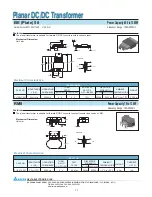
3. Planing hulls:
On planing hull boats with outboard motors or stern
drives, you should install the transducer close to the transom to ensure it
will be in the water at all times.
4. Noise:
When choosing a transducer location, keep in mind that ambient
noise is always present, from the mechanical noise made by the engine(s),
the movement of the hull through the water, and other sources. These
sound waves can interfere with the operation of the transducer. While am-
bient noise can't be eliminated, careful selection of a mounting location can
minimize the effect of vessel-generated noise. The lower the noise level, the
greater the sonar's unit's usable sensitivity.
5. Surface obstructions:
don't mount the transducer behind other
through-hull fittings. Such obstructions will interfere with the smooth
flow of water necessary for a clean sonar reading.
6. Clearance:
Make sure there is enough room on the inside of the hull
to install the transducer and there is clearance to attach the nut.
NOTE:
This transducer is designed to perform best in boats with a hull deadrise
of 10
°
or less. The transducer will work at greater angles, but it will be
sending signals off at an angle instead of straight to the bottom, so it
won't return true depth readings. The higher angle will also prevent the
transducer from performing to its full depth potential.
This transducer is designed for hulls with a deadrise of 10
°
or less.
Installing the Transducer in Your Boat's Hull
1. After you've determined the proper location for the transducer, drill a
1/8" (3.17 mm) pilot hole from inside the hull. Check the outside of the hull
to make sure there is no obstruction in the way, such as a strake. If you
find a problem with the chosen location, fill the pilot hole with the sealant-
adhesive compound and choose another mounting location.
2. The TH-FLWBL transducer requires a 2" (50.8 mm) hole. Using a hole
saw, drill from the outside of the hull to prevent the gel coat from crack-
ing on fiberglass hulls. Use eye and face protection when drilling the hole.
Afterwards, clean the area around the hole with detergent or alcohol.
This will establish a good surface for the adhesive.
2
Spread adhesive around the lip of the transducer housing and up around
the lower part of the sensor as shown.
3. Using the marine-grade sealant/adhesive, apply a 1/8" (3.17 mm) bead
of sealant around the lip of the transducer housing. Also spread the seal-
ant up around the lower part of the sensor housing, spreading it higher
on the housing than the hull is thick.
4. From the outside of the hull, pass the transducer cable up through the
hole, then push the transducer with sealant into it. Use a twisting motion
to squeeze out excess sealant. Remove excess sealant from the outside of
the hull before it dries, to ensure a smooth flow of water around the
transducer.
5. On the inside of the hull, slide the provided rubber washer over the
housing and install the nut. Hand-tighten the nut, being careful not to
over-tighten.
Do not use a wrench to tighten the nut!
After positioning the provided washer, use the provided nut to secure
the transducer in place.
3
Deadrise of
10
°
or less
Washer
Apply adhesive
liberally
Hull
Nut




















